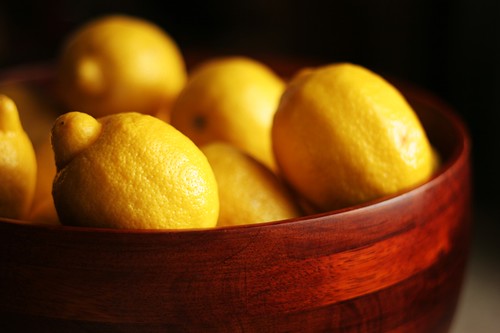anyone who's been to the west coast of italy knows about limoncello. it's a pretty special treat on a hot summer day. and even though it's fuh-reezing right now, late fall/early winter is actually the best time of year to make limoncello, because it's the beginning of lemon season. meyer lemons, one of the best things about california, also make delicious limoncello.
this recipe is from many beautiful things, a really beautiful cookbook-memoir by the late actor vincent schiavelli, who grew up in a sicilian-american home, hearing all sorts of fables about polizzi-generosa, the town his family was from in sicily.
materials:
canning jars
wine bottles
corks
gold coffee filters
Limuncinu
Lemon Liqueur
the italian name for this liqueur is limoncello. lately it has become quite fashionable and is found in fine restaurants throughout italy. limuncinu is best served cold from the freezer, which heightens the intense lemon flavor. freezing also gives its green-yellow color an exquisite opalescence.
the zest only from yellow and green lemons is used for this liqueur. it is essential that the fruit not be waxed. use homegrown or organic lemons (sometimes these, too, are waxed). to test, scrape the skin with the back stroke of a knife. if a white, waxy substance appears on the blade, the fruit has been waxed.
for approximately 5½ bottles, 750 ml each
12 unwaxed bright yellow lemons
3 unwaxed green (unripe) lemons
2 bottles (1.5 liters) 190-proof alcohol (eg. everclear. if you cannot get everclear, just use the highest-proof vodka you can find)
11 cups spring water
7½ cups sugar
wash and dry the lemons. using a zester, vegetable peeler, or very sharp paring knife, peel off the thin layer of colored zest. leave behind the white pith beneath (it would cause the liqueur to become cloudy and its bitterness would interfere with the lemon flavor).
put the zest in a clean, dry half-gallon sized canning jar.
pour in the alcohol.
after three days, prepare the syrup: place the water in a covered saucepan and heat it to boiling. remove the pan from the heat, remove the cover, and let the water cool for 2 minutes. stir in the sugar, letting it fall in a slow, constant stream. return the pan to very, very low heat and stir just until the sugar has dissolved and the liquid has turned clear. transfer the syrup to a clean jar to cool.
on the fourth day, sterilize the wine bottles for the limuncinu: place them in a sink and fill them with boiling water. after a few minutes, drain the bottles and let them cool. (because the alcohol content is a great deal higher than wine, the rigorous sterilization process required for that purpose is not necessary.)
filter the alcohol through a “gold” type coffee filter into a clean jar or bowl.
add 11½ cups of the sugar syrup to the alcohol. at this point, your limuncinu will be 68 proof (34% by volume). taste the liqueur. If more syrup is needed, at it ¼ cup or less at a time, mixing it in well and taking a small taste after each addition.
bottle the liqueur. let the air bubbles escape before corking. if any cloudy residue has risen to the top, blot it with the corner of a paper coffee filter ore remove it with a glass dropper.
prepare the corks by boiling them in water for 5 minutes. cork the bottles.
write out the labels. when the ink has dried, glue them to the bottles with white glue. place a sheet of scrap paper on a smooth work surface, and roll the labeled bottle on it to make sure the label is well sealed.
freeze the limuncinu overnight before serving. return the bottle to the freezer for storage.
source:
the oak barrel--wine bottles, corks, and wax
12.13.2007
handmade gift: homemade limoncello (limuncinu)
Subscribe to:
Post Comments (Atom)


yummy! i'm going to make some as soon as i can find a lemon tree to filch from. thanks for passing on the knowledge.
ReplyDeleteoh this is the BEST stuff ever. thank you for the recipe! hope that your hand feels better. ouch.
ReplyDelete